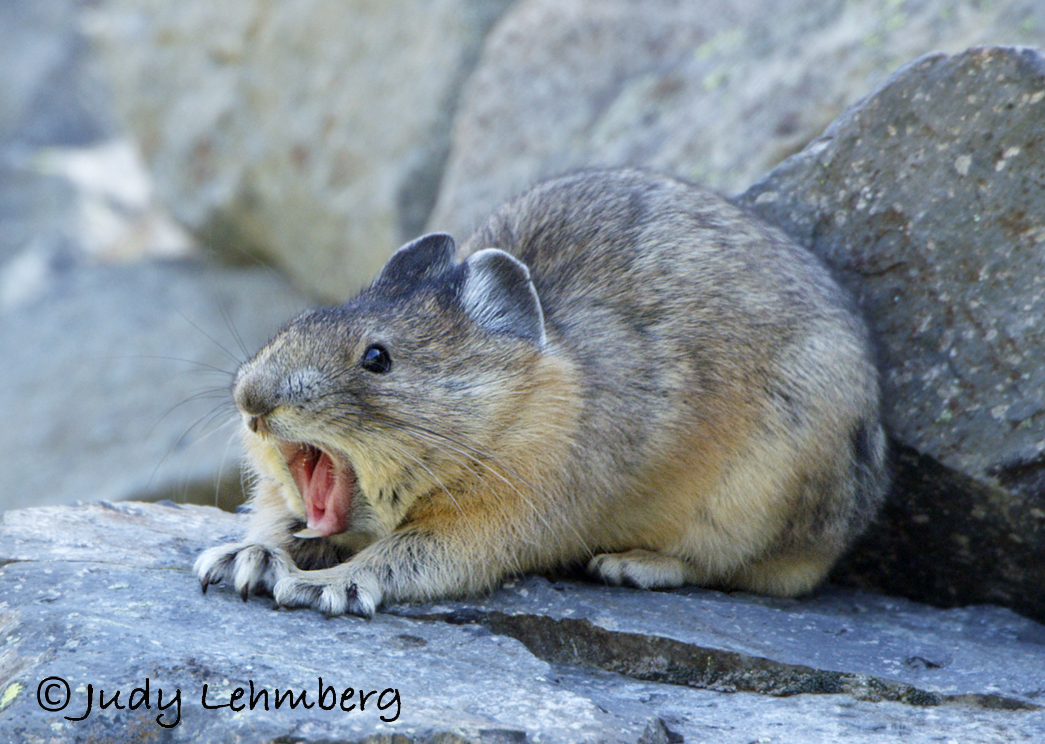
I absolutely love pikas! They are the cutest little animals I know of. They don’t look like rabbits, but they are; rabbits that are superbly adapted to mountain tops. They look a lot like rodents but if you are able to look close enough you will see they are rabbits. All rodents have 2 top incisors and 2 bottom incisors. Rabbits have 4 incisors on the top and 2 on the bottom.
As I said pikas are well adapted for extremely cold environments. That is why they don’t look like rabbits. If they had the typical long ears of rabbits they would freeze to death. Animals that are well adapted to cold environment must reduce their surface area to volume ratio. Over thousands of years they have developed short ears, no tail, and short legs. Pikas are so well adapted to cold environments that 2 hours at 78 degrees will kill them. That has become a real concern as the earth warms.
The pika below is a male. I guess you know that though!

Pikas are unusual animals. They don’t hibernate even though they live in some of the coldest areas on earth. To survive the cold, long winters they collect “hay” all summer and create haystacks. The haystacks are composed of many species of plants. They love raspberry plants but they collect a wide variety of plants including some that are toxic. As they collect the plants they stack them in piles to dry. They rotate the piles so all of the plants dry and then stack them in protected areas amongst the rocks where they live. During the long winters the toxic plants protect the rest of the plants from fungi and insect damage. The pikas do eat the toxic plants but they somehow know to eat them last, after they have lost their toxicity.

Besides their teeth pikas do have other things in common with other rabbits and one commonality is they eat their own feces. That way they get more nutrients out of their food.


As I have mentioned before we have been visiting Yellowstone for 40 years. Forty years ago we photographed pikas in a bunch of places in Yellowstone. Several of those places don’t have pikas anymore, due to the increase in temperature. In fact they are listed as 1 of 5 species most vulnerable to climate change.
Our photos are available at www.vernelehmberg.com. Watch for an upcoming sale soon.














They are one of my favorites…These pictures are just so wonderful…They really are so adorable…so little and so sweet. I have seen and heard a few hiking in the higher elevations of the Sierra Mountain Range in CA…and it is always such a treat to see them. I did not know they eat their own feces..very interesting how they rotate their haystacks around for drying..such smart little ones! Thank you so much
Can’t quit giggling! Great shots and I loved your story. I am home now!
I have to say I can’t quit giggling either, not only because I love pikas, but because I got the “bull pika” as Verne calls him stretching and yawning while Verne was screwing around. Thank you Deby! You will have to go to that pika spot sometime. He is not shy.
Thank you Kitty. If you think they are cute in photos you should see them in person! I have never seen anyone see them for the first time who didn’t think they were adorable (except for 1 rather nasty lady who thought we were looking at bears, with our cameras pointed at rocks 20 feet in front of us, but she doesn’t count because she was an idiot.) If you email me at jlehmber@lee.edu and tell me what part of the park you plan to be in I will give you some places to look.
Judy, those are adorable. I am always learning something from your photos and articles, and I must look for some of those little cuties when we visit the park next year.